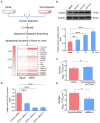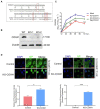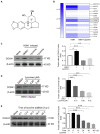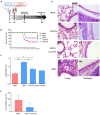Identification of cytochrome c oxidase subunit 4 isoform 1 as a positive regulator of influenza virus replication
- PMID: 35928150
- PMCID: PMC9343726
- DOI: 10.3389/fmicb.2022.862205
Identification of cytochrome c oxidase subunit 4 isoform 1 as a positive regulator of influenza virus replication
Abstract
Human infection with highly pathogenic H5N1 influenza virus causes severe respiratory diseases. Currently, the drugs against H5N1 are limited to virus-targeted inhibitors. However, drug resistance caused by these inhibitors is becoming a serious threat to global public health. An alternative strategy to reduce the resistance risk is to develop antiviral drugs targeting host cell proteins. In this study, we demonstrated that cytochrome c oxidase subunit 4 isoform 1 (COX41) of host cell plays an important role in H5N1 infection. Overexpression of COX41 promoted viral replication, which was inhibited by silencing or knockout the expression of COX41 in the host cell. The ribonucleoproteins (RNPs) of H5N1 were retained in the cell nucleus after knockout cellular COX41. Strikingly, inhibition of cellular COX41 by lycorine, a small-molecule compound isolated from Amaryllidaceae plants, reduced the levels of COX41-induced ROS and phosphorylation of extracellular signal-regulated kinase (ERK) in cells, thus resulting in the blockage of nuclear export of vRNP and inhibition of viral replication. In H5N1-infected mice that were treated with lycorine, we observed a reduction of viral titers and inhibition of pathological changes in the lung and trachea tissues. Importantly, no resistant virus was generated after culturing the virus with the continuous treatment of lycorine. Collectively, these findings suggest that COX41 is a positive regulator of H5N1 replication and might serve as an alternative target for anti-influenza drug development.
Keywords: COX41; anti-influenza; highly pathogenic H5N1 influenza virus; lycorine; viral ribonucleoproteins export.
Copyright © 2022 He, Huang, Li, Li, Zhao, Li, Ye, Qi, Tang and Wang.
Conflict of interest statement
The authors declare that the research was conducted in the absence of any commercial or financial relationships that could be construed as a potential conflict of interest.
Figures






Similar articles
-
Amaryllidaceae alkaloids inhibit nuclear-to-cytoplasmic export of ribonucleoprotein (RNP) complex of highly pathogenic avian influenza virus H5N1.Influenza Other Respir Viruses. 2013 Nov;7(6):922-31. doi: 10.1111/irv.12035. Epub 2012 Nov 8. Influenza Other Respir Viruses. 2013. PMID: 23136954 Free PMC article.
-
Verdinexor, a novel selective inhibitor of nuclear export, reduces influenza a virus replication in vitro and in vivo.J Virol. 2014 Sep 1;88(17):10228-43. doi: 10.1128/JVI.01774-14. Epub 2014 Jun 25. J Virol. 2014. PMID: 24965445 Free PMC article.
-
14-Deoxy-11,12-dehydroandrographolide exerts anti-influenza A virus activity and inhibits replication of H5N1 virus by restraining nuclear export of viral ribonucleoprotein complexes.Antiviral Res. 2015 Jun;118:82-92. doi: 10.1016/j.antiviral.2015.03.008. Epub 2015 Mar 20. Antiviral Res. 2015. PMID: 25800824
-
Tandem mass tag-based quantitative proteomic analysis of lycorine treatment in highly pathogenic avian influenza H5N1 virus infection.PeerJ. 2019 Oct 2;7:e7697. doi: 10.7717/peerj.7697. eCollection 2019. PeerJ. 2019. PMID: 31592345 Free PMC article.
-
Role of sulfatide in influenza A virus replication.Biol Pharm Bull. 2015;38(6):809-16. doi: 10.1248/bpb.b15-00119. Biol Pharm Bull. 2015. PMID: 26027821 Review.
Cited by
-
Targeted isolation of antiviral cinnamoylphloroglucinol-terpene adducts from Cleistocalyx operculatus by building blocks-based molecular networking approach.Acta Pharm Sin B. 2024 Oct;14(10):4443-4460. doi: 10.1016/j.apsb.2024.04.031. Epub 2024 May 3. Acta Pharm Sin B. 2024. PMID: 39525571 Free PMC article.
-
A new mechanism of respiratory syncytial virus entry inhibition by small-molecule to overcome K394R-associated resistance.mBio. 2024 Sep 11;15(9):e0138524. doi: 10.1128/mbio.01385-24. Epub 2024 Aug 20. mBio. 2024. PMID: 39162560 Free PMC article.
-
Mitochondrial Oxidative Phosphorylation in Viral Infections.Viruses. 2023 Dec 4;15(12):2380. doi: 10.3390/v15122380. Viruses. 2023. PMID: 38140621 Free PMC article. Review.
References
LinkOut - more resources
Full Text Sources
Miscellaneous

